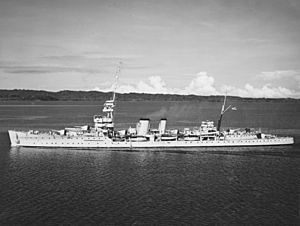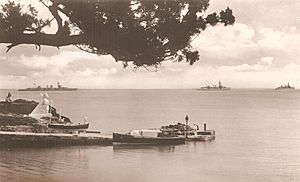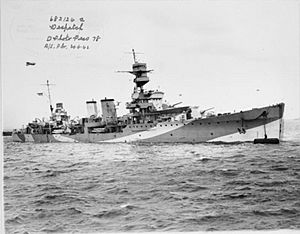HMS Despatch (D30) facts for kids

HMS Despatch in October 1939
|
|
Quick facts for kids History |
|
|---|---|
| Name | HMS Despatch |
| Ordered | March 1918 |
| Builder | Fairfield Shipbuilding and Engineering Company, Govan |
| Laid down | 8 July 1918 |
| Launched | 24 September 1919 |
| Commissioned | 2 June 1922 |
| Identification | Pennant number D30 |
| Fate | Sold for scrap, 5 April 1946 |
| General characteristics (as built) | |
| Class and type | Danae-class light cruiser |
| Displacement | 4,970 long tons (5,050 t) |
| Length |
|
| Beam | 46 ft 9 in (14.2 m) |
| Draught | 16 ft 11 in (5.16 m) (mean, deep load) |
| Installed power |
|
| Propulsion | 2 × shafts; 2 × geared steam turbines |
| Speed | 29 kn (54 km/h; 33 mph) |
| Complement | 460 |
| Armament |
|
| Armour |
|
| Notes | Received a Le Cheminant deck watch from the Royal Observatory on 23 January 1933. |
HMS Despatch was a fast and powerful warship called a light cruiser. She was built for the Royal Navy (Britain's navy) during World War I. She belonged to a group of ships known as the Danae class, specifically the Delhi sub-class.
Contents
Ship Design and Features

The Delhi sub-class ships, like Despatch, were very similar to earlier ships. However, their front (bows) was raised. This helped them handle rough seas better.
Size and Power
These ships were about 472 feet 6 inches (144.0 m) long from end to end. They were 46 feet 9 inches (14.2 m) wide. When fully loaded, they sat about 16 feet 11 inches (5.2 m) deep in the water. Despatch weighed about 4,970 long tons (5,050 t).
The ship was powered by two large steam turbine engines. These engines produced a lot of power, making the ship go very fast. They used steam from six special Yarrow boilers. This allowed Despatch to reach speeds of about 29 knots (54 km/h; 33 mph) (about 33 miles per hour). She could carry 1,050 long tons (1,067 t) of fuel oil. A crew of about 450 sailors and officers worked on the ship.
Ship's Weapons
Despatch was armed with six main guns, called 6-inch (152 mm) Mk XII guns. These were placed along the center of the ship. Two guns were at the front, two in the middle, and two at the back.
She also had two 4-inch anti-aircraft guns. These were used to shoot down enemy planes. There were also two smaller 2-pounder anti-aircraft guns. For attacking other ships, Despatch carried twelve 21-inch (533 mm) torpedo tubes. These were in four groups of three, two on each side of the ship.
Building and Service History
Despatch was started by the Fairfield Shipbuilding and Engineering Company on July 8, 1918. She was launched into the water on September 24, 1919. The ship was then taken to Chatham Dockyard to be finished. She was officially ready for service on June 15, 1922.
Early World War II Operations
Compared to her sister ships, Despatch had a fairly calm time during the early parts of World War II. She spent the beginning of the war in the South Atlantic Ocean. There, she successfully captured a German cargo ship named Düsseldorf. She also found another German merchant ship, Troja. However, the crew of Troja sank their own ship before Despatch could capture it.
Later in 1940, Despatch moved to the Mediterranean Sea. She helped protect groups of supply ships, known as convoys. She was also involved in two important naval events: Operation White and the Battle of Cape Spartivento.
In February 1943, HMS Despatch stopped a Spanish ship, Monte Naranco. An armed guard was placed on board, and a Greek destroyer, HHelMS Adrias, was ordered to escort it towards Gibraltar.
Normandy Landings and Final Years
One of the most important moments for Despatch was her role in the Normandy landings in June 1944. This was a huge invasion during World War II. Despatch served as the headquarters ship for the Mulberry harbours. These were special temporary harbors built to land supplies and troops in France.
While at Mulberry 'B' harbour, King George VI visited Despatch. For her role as a headquarters ship, all of Despatch's original guns were removed. They were replaced with 16 Bofors 40 mm anti-aircraft guns. These guns were operated by soldiers from the 127th (Queen's) Light Anti-Aircraft Regiment. Their job was to help control traffic and protect the Mulberry Harbour at Arromanches.
In January 1945, Despatch was put into reserve, meaning she was no longer actively used. On April 5, 1946, she was sold to be broken up for scrap metal. She arrived at the yards of Arnott Young in Troon, Scotland, on May 5, 1946, to be dismantled.
Images for kids
-
HMS Despatch with her sister ships, HMS Dragon and HMS Danae, in 1931. They are leaving Bermuda for exercises.





